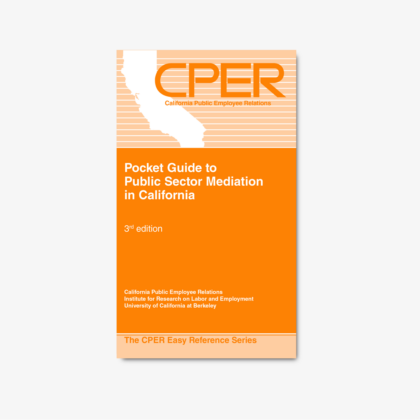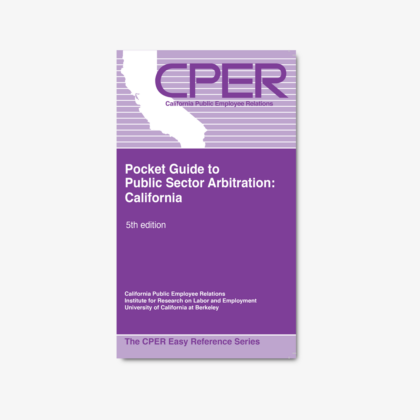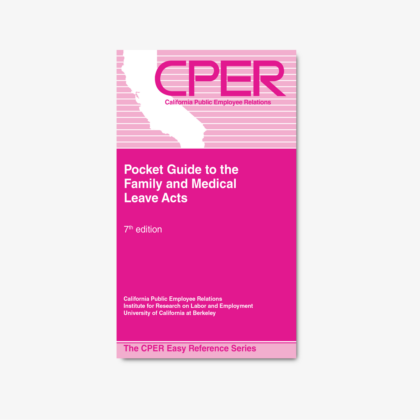The Pocket Guide to Workers’ Compensation in California gives an overview of workers’ compensation law and procedure. It provides a brief history of the law and a summary of citations to applicable statutes, regulations, and precedent cases. The guide includes pertinent resources, a glossary, and an index of terms.
The guide covers:
-
- Stages of a compensation claim
- Benefits
- Rights and obligations
- Labor-management carve-outs
- Rights of employees whose employers are illegally uninsured
- How workers’ compensation law relates to disability rights laws, job-protected leave laws, and public benefits
The guide is a valuable reference and training tool, and helpful to anyone who needs to understand the workers’ comp process in both the public and private sectors in California.
Table of Contents
- Scope and Operation of the Workers’ Compensation System (Page 1)
- Introduction (Page 1)
- California workers’ compensation laws apply to most injuries and illnesses caused by employment (Page 2)
- Injured workers may not sue the employer in court, and benefits are limited (Page 3)
- Employers are required to have insurance (Page 4)
- Coverage of post-termination claims is limited (Page 4)
- Coverage of psychiatric injuries is limited (Page 5)
- Sleep dysfunction and sexual dysfunction claims also limited (Page 6)
- Five categories of benefits are paid (Page 6)
- Administrative law judges adjudicate disputes (Page 7)
- Preliminary Rights and Responsibilities (Page 8)
- Employers and workers can prevent injuries and illnesses (Page 8)
- Some workers may predesignate their personal physician (Page 8)
- Employers and unions may create labor-management carve-outs (Page 10)
- Requesting Benefits After Injury (Page 11)
- The injured worker should inform the employer and get emergency treatment if needed (Page 11)
- Filing a claim form preserves the injured worker’s rights (Page 12)
- Employees of illegally uninsured employers may sue the employer and apply for Uninsured Employers Benefits Trust Fund benefits (Page 14)
- Presumptions of compensability apply to public safety officers (Page 15)
- Medical Care (Page 15)
- Employers and providers may not collect payment from an injured worker for medical care (Page 17)
- Scientifically based medical treatment guidelines govern care (Page 17)
- Claims administrators must promptly authorize treatment (Page 18)
- The primary treating physician has a role in determining benefits (Page 19)
- How the initial primary treating physician is selected depends on whether the worker predesignated and whether there is a medical provider network (MPN) or health care organization (HCO) (Page 19)
- The injured worker’s rights to switch primary treating physicians depend on whether the worker is being treated in an MPN or HCO and whether the worker predesignated (Page 21)
- Disputes over out-of-network medical treatment (Page 22)
- Resolving Problems with Medical Care and Medical Reports (Page 24)
- An injured worker may discuss concerns with a treating physician or switch physicians (Page 24)
- Steps to dispute a treating physician’s opinion about necessary care depend on whether the injured worker is being treated in an MPN or HCO (Page 24)
- Decisions to authorize care are made in a utilization review (UR) process, followed by an Independent Medical Review (IMR) appeal process (Page 25)
- The injured worker has the right to challenge a decision denying treatment (Page 26)
- The injured worker and the claims administrator may dispute a treating physician’s opinion on matters other than treatment (Page 27)
- A medical evaluation is required to dispute an opinion by a treating physician or a decision to deny care (Page 28)
- Temporary Disability Benefits (Page 30)
- Temporary disability (TD) benefits are paid to injured workers who are disabled while recovering (Page 30)
- Payment amounts depend on lost wages (Page 31)
- TD benefits are paid on a schedule (Page 31)
- Penalties are payable for delays (Page 32)
- When TD payments end is based on the worker’s medical condition, return to work, or duration of payments (Page 32)
- Working After Injury (Page 34)
- Workers’ compensation law prohibits discrimination against workers with job injuries (Page 34)
- The treating physician determines work capacities and restrictions (Page 35)
- The employer may reduce its liability for certain benefits by offering work (Page 35)
- Actions taken in a workers’ compensation claim do not eliminate rights and obligations under disability rights laws (Page 37)
- Permanent Disability Benefits (Page 40)
- Permanent disability (PD) benefits are paid to workers who will always be limited in their ability to work (Page 40)
- Benefits depend in part on a medical report (Page 41)
- The worker’s disability is given a permanent disability rating (Page 41)
- Payment amounts depend on ratings of the disability, date of injury, pre-injury wages, and whether the employer offers work (Page 43)
- PD benefits are paid on a schedule (Page 43)
- Penalties are payable for delays (Page 44)
- PD benefits are commonly settled (Page 44)
- Supplemental Job Displacement Benefits (Page 46)
- A supplemental job displacement benefit (SJDB) is a voucher that promises to pay for educational retraining or skill enhancement (Page 46)
- Benefit amounts depend on the worker’s permanent disability rating (Page 47)
- Voucher expiration date (Page 47)
- Sources of Further Information and Help (Page 48)
- California agencies (Page 48)
- Reference materials (Page 49)
- Glossary (Page 50)
- Index (Page 61)




